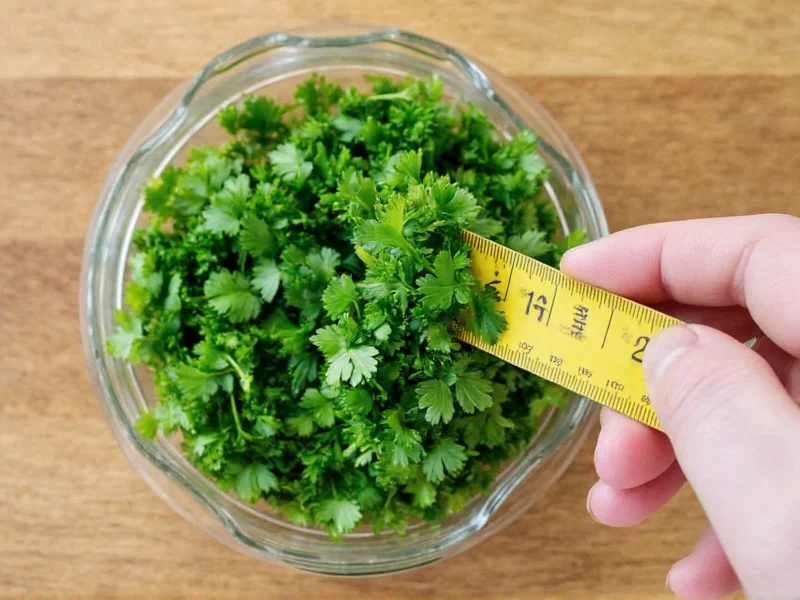The standard conversion for fresh parsley to dried measurement is 1 tablespoon of fresh parsley equals 1 teaspoon of dried parsley. This 3:1 ratio accounts for the water content difference between fresh and dried herbs, ensuring proper flavor concentration in your recipes.
Understanding herb conversions is essential for consistent cooking results. When substituting dried parsley for fresh in your recipes, you need to adjust measurements to maintain the intended flavor profile. The difference stems from water content—fresh parsley contains about 85% water, while dried parsley has most moisture removed, concentrating the flavor compounds.
Why the 3:1 Conversion Ratio Matters
Fresh herbs contain significant water content that dilutes their flavor intensity. When herbs are dried, this water evaporates, leaving behind more concentrated essential oils and flavor compounds. For parsley specifically, this concentration means dried parsley delivers approximately three times the flavor punch of its fresh counterpart.
Chefs and food scientists confirm this ratio through practical testing in recipe development. Using equal amounts of fresh and dried parsley would result in dishes that are either too mild (when using fresh) or overpowering (when using dried).
Fresh Parsley to Dried Measurement Conversion Chart
| Fresh Parsley | Dried Parsley | Best For |
|---|---|---|
| 1 teaspoon | ⅓ teaspoon | Garnishes, finishing touches|
| 1 tablespoon | 1 teaspoon | Standard recipe substitution|
| ¼ cup | 1¼ tablespoons | Sauces and dressings|
| ½ cup | 2½ tablespoons | Stews and long-cooking dishes|
| 1 cup | 5 tablespoons | Large batch cooking
When to Use Fresh vs. Dried Parsley
Understanding fresh parsley to dried measurement equivalents is only part of the equation. The timing of when you add each form to your dish significantly impacts flavor development:
Fresh parsley works best as a finishing herb. Its delicate flavor compounds are heat-sensitive, so adding it during the last few minutes of cooking or as a garnish preserves its bright, grassy notes. Fresh parsley excels in dishes like tabbouleh, chimichurri, or as a final sprinkle on soups and roasted meats.
Dried parsley performs better in long-cooking applications where its more stable flavor compounds can gradually infuse the dish. Use dried parsley in tomato sauces that simmer for hours, spice rubs, or dry marinades where fresh would become soggy or lose its texture.
Practical Substitution Tips
When converting fresh parsley to dried measurement in your recipes, consider these professional kitchen insights:
- Crush dried herbs between your fingers before adding them to release more flavor compounds
- For soups and stews, add dried parsley 15-20 minutes before completion to allow proper rehydration and flavor integration
- When substituting in baking recipes (like herb breads), use 25% less dried parsley than the conversion chart suggests, as oven heat intensifies dried herb flavors
- Store dried parsley properly in airtight containers away from light and heat to maintain potency for up to 18 months
Avoiding Common Measurement Mistakes
Many home cooks make critical errors when converting fresh parsley to dried measurement that compromise their dishes:
Overpacking dried herbs - Unlike fresh parsley which you can loosely chop, dried parsley tends to settle densely. Always measure dried herbs by lightly spooning them into your measuring spoon rather than scooping directly from the container.
Ignoring recipe context - Some recipes already account for herb intensity. If a recipe specifically calls for "dried parsley," don't automatically apply the conversion ratio to fresh.
Not adjusting for herb quality - Older dried parsley loses potency. If your dried parsley is more than a year old, consider using 20-25% more than the standard conversion suggests.
Storage Considerations for Optimal Flavor
Proper storage affects how your fresh and dried parsley measurements translate to actual flavor in dishes:
Fresh parsley maintains peak flavor for 5-7 days when stored properly. Trim the stems, place in a glass with an inch of water, cover loosely with a plastic bag, and refrigerate. Change water every other day. After two weeks, fresh parsley loses significant flavor intensity, requiring slightly more than standard measurements.
Dried parsley retains optimal potency for 12-18 months when stored in airtight containers away from light and heat. Beyond this timeframe, you may need to increase measurements by 25-50% to achieve the same flavor impact.











 浙公网安备
33010002000092号
浙公网安备
33010002000092号 浙B2-20120091-4
浙B2-20120091-4